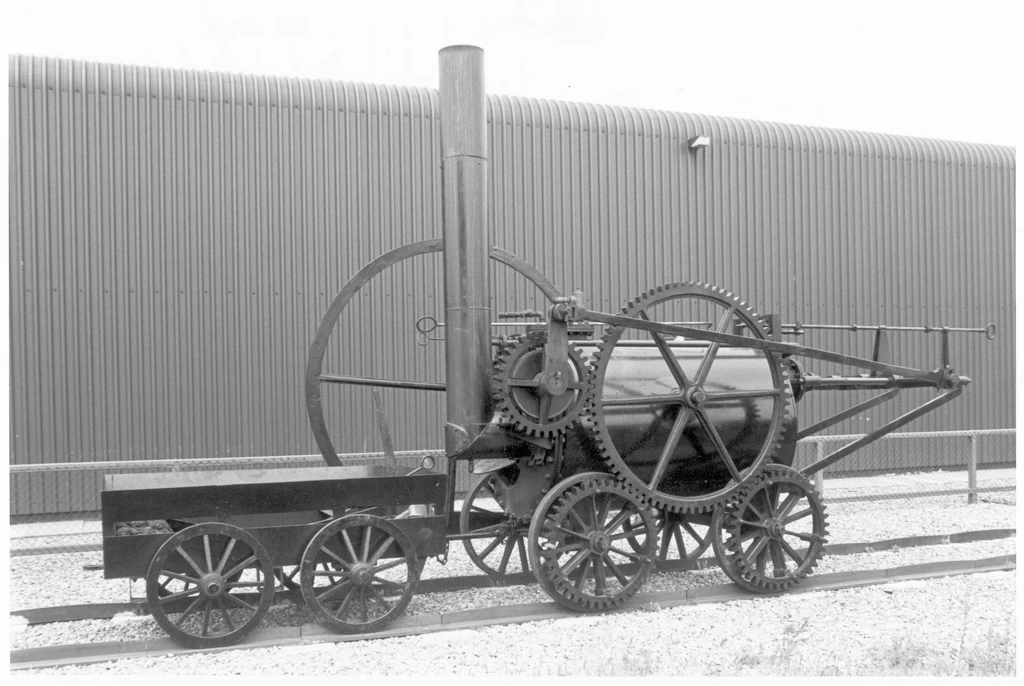Richard Trevithick’s steam locomotive
The replica locomotive in its present home, the National Waterfront Museum.
The Penydarren loco
On 21 February 1804, the world’s first ever railway journey ran 9 miles from the ironworks at Penydarren to the Merthyr–Cardiff Canal, south Wales. It was to be several years before steam locomotion became commercially viable, meaning that Richard Trevithick and not George Stephenson was the real father of the railways.
In 1803, Samuel Homfray brought Richard Trevithick to his Penydarren ironworks at Merthyr Tydfil in South Wales. Homfray was interested in the high pressure engines that the Cornishman had developed and installed in his road engines.
He encouraged Trevithick to look into the possibility of converting such an engine into a rail-mounted locomotive to travel over the newly laid tramroad from Penydarren to the canal wharf at Abercynon.
Crawshay’s wager
It would appear that Trevithick started work on the locomotive in the autumn of 1803 and, by February 1804, it was completed. Tradition has it that Richard Crawshay, owner of the nearby Cyfarthfa ironworks, was highly sceptical about the new engine, and he and Homfray placed a wager of 500 guineas each with Richard Hill (of the Plymouth ironworks) as to whether or not the engine could haul ten tons of iron to Abercynon, and haul the empty wagons back.
The first run was on 21 February, and was described in some detail by Trevithick:
‘...yesterday we proceeded on our journey with the engine, and we carried ten tons of iron in five wagons, and seventy men riding on them the whole of the journey... the engine, while working, went nearly five miles an hour; there was no water put into the boiler from the time we started until our journey’s end... the coal consumed was two hundredweight’.
Unfortunately, on the return journey a bolt sheared, causing the boiler to leak. The fire then had to be dropped and the engine did not get back to Penydarren until the following day.
This gave Crawshay reason to claim that the run had not been completed as stipulated in the wager, but it is not known if this was ever settled!
The engine was, in fact, too heavy for the rails. Later, it would serve as a stationary engine driving a forge hammer at the Penydarren works.
Replica locomotive
The replica locomotive on display in the Museum today was built working from Trevithick’s original documents and plans (now in the National Museum of Science and Industry). It was inaugurated in 1981 and, ironically, presented the exact same problem as the original engine – it too broke the rails on which it ran!
We cannot overestimate the importance of Trevithick’s locomotive. In 1800, the fastest a man could travel over land was at a gallop on horseback; a century later, much of the world had an extensive railway system on which trains regularly travelled at speeds of up to sixty miles per hour. This remarkable transformation, a momentous occasion in world history, was initiated in south Wales in that February of 1804.
The Penydarren locomotive – Steaming Days
A short film documenting the yearly steaming of Richard Trevithick’s replica locomotive at the National Waterfront Museum, Swansea.


Comments - (23)
Nothing better than steam engines andRichard Trevethick getting his recognition!
Than’ you aga8n!
replica at the National Waterfront Museum of Wales. In the 1960s when I was school , there was a large model (now hidden in the basements) in Cyfartha Museum of what
was thought to be the Penydarren but was actually the Coalbrookdale Locomotive ( made by Airfix as Andrew Longdon's comment ) in the 1960s. As John Hellin points out,
the National Railway Museum at York puts emphasis on Stockton and Darlington 1825 and Stephenson's Rocket 1829, not Richard Trevithick and Merthyr Tydfil 1804.
Even in 1962, I remember we had some debate as to where the front of the Penydarran locomotive was - the chimney end or the flywheel and where the fire box was
and whether Terence Cuneo's 1962 rendition is as it was.
Norman Chang, London and Merthyr Tydfil born.
Thanks guys.
Hi Andrew,
Thank you for getting in touch with us. A number of our staff are currently on furlough, including my colleague who would be able to advise on your enquiry. I will make sure your question is passed and as soon as she is back in work she will be able to provide you with an answer.
Many thanks,
Nia
(Digital team)
I say it's a model of this loco, but despite the description on the box "1804 Steam Locomotive" and references to Richard Trevithick and "Pen-y-darran", close inspection tells me either Airfix basically looked at a mirror image of the original plans or it's a different loco!
Are you familiar with the Airfix model - can you confirm whether it is meant to replicate the loco you have here...?
Thanks.
Dear Tim Smith,
Thank you for your email.
The 1834 newspaper report appears to concern the explosion of a different Trevithick-designed steam engine. Richard Trevithick's Penydarren locomotive of 1804 is not recorded as exploding.
The full-size live-steam conjectural reconstruction of the Penydarren locomotive which was built by Amgueddfa Cymru - National Museum Wales in 1981 is displayed at the National Waterfront Museum at Swansea, where it is periodically demonstrated in steam - see the museum website for details (https://museum.wales/swansea/). The Museum is temporarily closed due to Covid-19.
Yours sincerely,
Jennifer Protheroe-Jones
Principal Curator - Industry
Where is the replica engine now? The one at Cytarthfa Castle Museum in Merthyr Tydfil appears to be a full scale model.
Absolutely brilliant site,and most interesting and informative.If we ever get shut of this damned virus I should dearly love to visit the museum.In the meantime I intend to order the disc with
plans of the Penydarren Locomotive from the museum's Image Licencing Officer with a view to building a working model.
Many Thanks.
Yours Sincerely,
Brian Flynn,